Well, not between Sunrise and Sunset - the sky is far too bright.
The Earth has an atmosphere. Here it is shown as a ring of constant width and colour, but it actually stretches hundreds of kilometres into space, getting thinner as it does so.

At about 10 km, the height of Mount Everest or the cruising height of a passenger aircraft, you are above more than 90% of it.
Tiny particles in the atmosphere, dust and pollen, droplets of water and crystals of ice, even the molecules of the gases in the air, scatter the light of the Sun. Some of the light from the Sun reaches us directly from the Sun but most comes from every part of the sky where it has been scattered by the atmosphere - this is why it is still bright when the Sun itself goes behind a cloud. So during the day the whole sky is quite bright, too bright to see the stars (and also the planets).
The Moon has no atmosphere, neither does space of course, so from the Moon or a spacecraft the sky is totally black even when it is “daytime.”
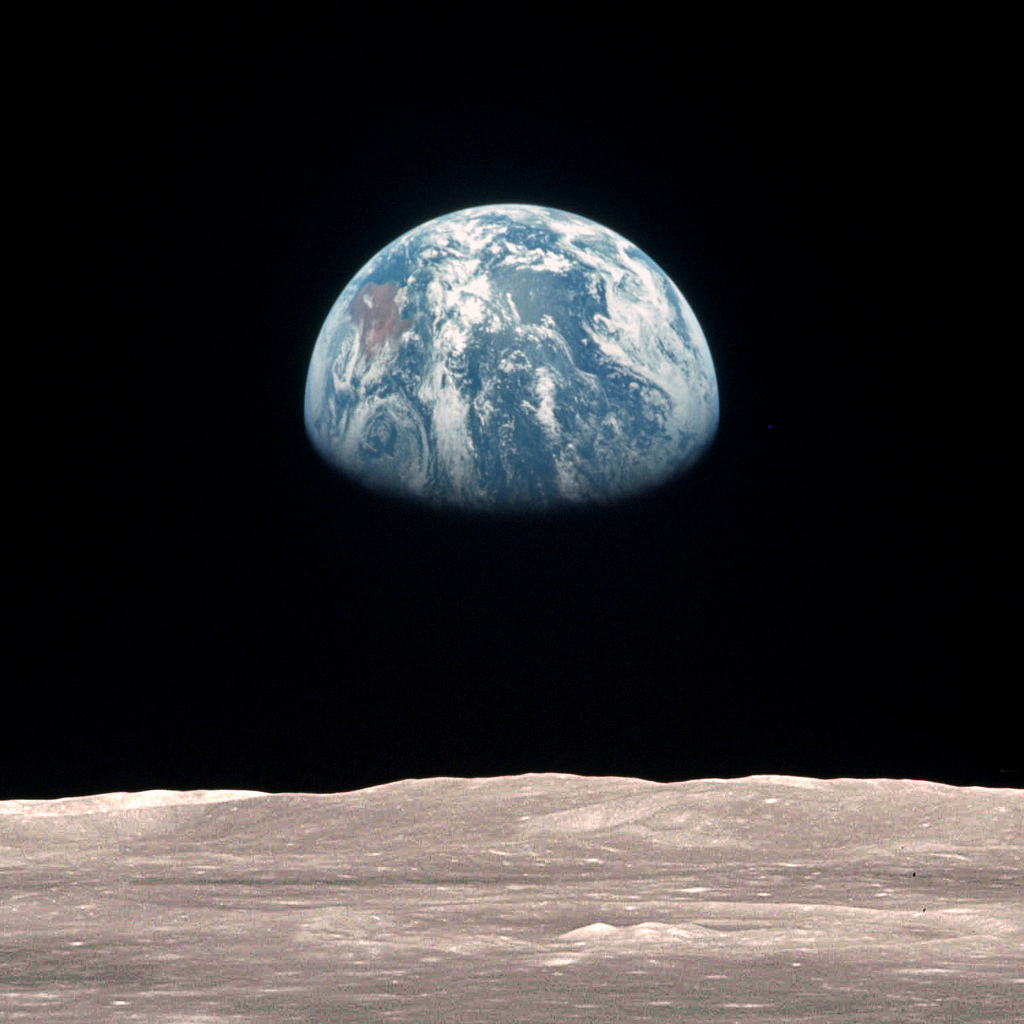
But you do not usually see the stars in photographs taken from the Moon because the people taking the photographs are not on the Moon to look at the stars, and so are not using the right cameras and settings to show them. In the same way people on the Earth can take photographs of the stars, but not with ordinary settings on ordinary cameras.
Sunlight is actually “all the colours of the rainbow” - this is explained on another Page, but which is nothing to do with astronomy. The different wavelengths of the sunlight are scattered in different ways, depending upon the size of the particles and the angle at which the Sun strikes them, so during the day the sky is usually blue, but near Sunrise and Sunset (or after a volcanic eruption or a desert sandstorm, when there is a lot of ash and dust in the air) it may be different colours. Ice crystals also scatter light in this way so although fresh snow is white when you look down on it it is blue if you look through it so the light inside ice caves is blue: do a web search on “ice caves” for some wonderful images.
This picture shows the Earth and its atmosphere and the light from the Sun.
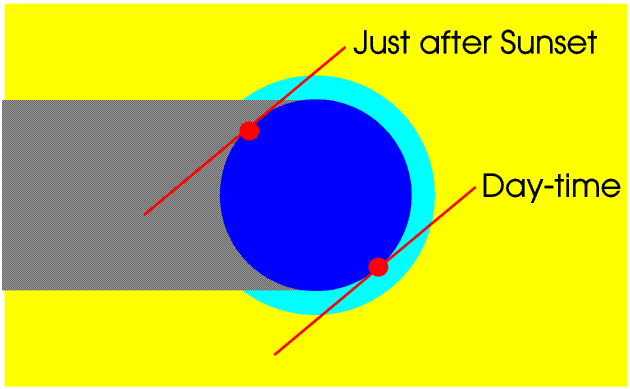
The Earth is rotating on its axis anti-clockwise. From this picture we can see that at any time between Sunrise and Sunset the whole of the sky above us is in the light of the Sun, but just after Sunset only a part of it is and soon afterwards none of it will be. So we shall start seeing the brightest stars a few minutes after Sunset, and gradually more and more, until the sky is totally dark - this is Nightfall. The time between Sunset and Nightfall has many names, for example dusk, although some people use dusk to mean just the last part of it. To many people, including Jews and Moslems, it is a very special time.
There is of course a similar period before Sunrise, this is called dawn. The beginning of dawn and the ending of dusk are called astronomical twilight.
.You can play a game watching the stars come out, it is described on an earlier Page.
The Earth rotates on its axis once every twenty four hours (this is of course why the Sun and Moon and stars and planets rise and set) and its axis is tilted by about 23½ degrees. Britain is about half way between the Equator and the North Pole, so this picture shows what stars are above the horizon in Britain at a certain time.
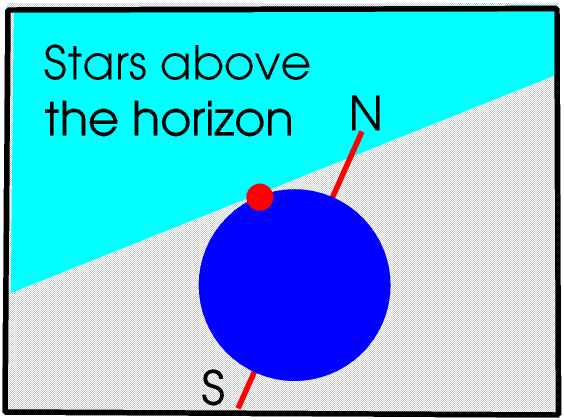
The next picture shows the stars that are above the horizon twelve hours later.
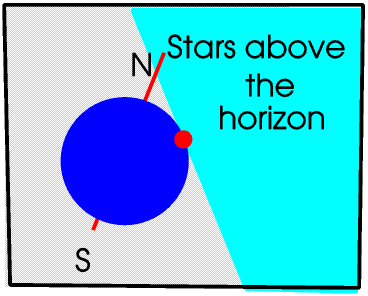
Of course whether you can actually see the stars that are above the horizon depends on whether it is day-time or night-time.
If we put the two together we shall have this.
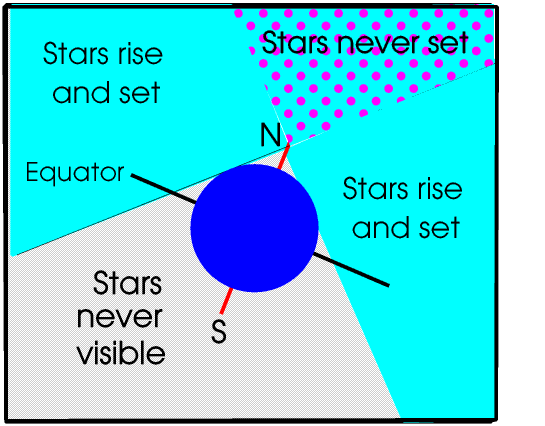
There are three regions of the sky
One where they rise and set. Although there will always be lots of stars visible every night they will not always be the same stars, because you can only see the stars and constellations which are on the opposite side of the Earth to the Sun so will be different in the summer and the winter.
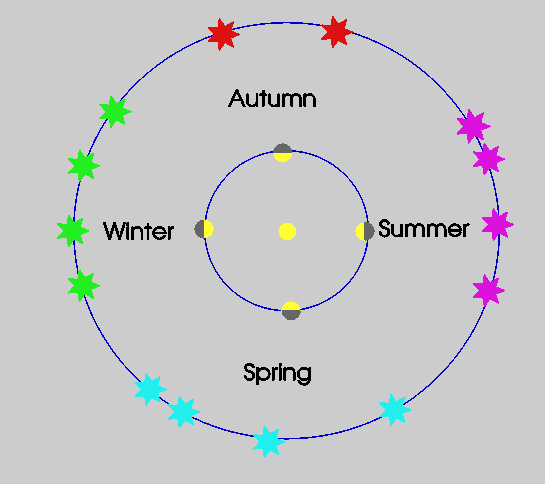
These regions of course depend upon your latitude, how far you live North or South of the Equator, so people in Australia can see constellations which the Greeks and Romans could never have seen, and later European astronomers had to invent Latin-sounding names for them - the names the existing inhabitants had been using for thousands of years before Europeans “discovered” their country were not good enough for them.
The stars which never rise and set are called the circumpolar stars, from the Latin for around the Pole. They rotate round the North Celestial Pole, the point in the sky above the terrestrial North Pole. At present the star which we call Polaris, or the Pole Star, is very close to the Celestial North Pole, but because of precession it has not always been. Precession is something which happens very slowly, over hundreds of years, so it is not important if you just like looking at the Night Sky, but it is important if you are interested in the history of astronomy or want to know how some of the things in the sky got their names. You can read about it on its own Page.
Which constellations are circumpolar depend on where you live, your latitude. People living in the Southern Hemisphere will see the constellations round the South Celestial Pole, which they think are much prettier.
The circumpolar constellations and stars were special to the Ancient People because they never set, that is, they never sank into the sea or disappeared into the Earth.
From most of Europe, including Britain and Greece and Rome, Ursa Major and Ursa Minor, the Great Bear and the Little Bear in Latin, are circumpolar constellations, circling round a point in the middle of the sky. The Greeks only had one Bear. Today the Arctic Circle is just a line drawn on a map or globe, but it comes from the Greek word Arctos for bear, and originally meant “The Circle of the Bear.”
“Sam’s Birthday Star” was named by his Dad because just after Sam was born it was shining very brightly through the hospital window. It does of course have a real name but Sam and his Dad and Grandad have always called it his Birthday Star, and always make a special point of looking at it together on (each anniversary of) his birthday. It is typical of any non-circumpolar star.
It rises and sets because the Earth is rotating on its axis, but like all stars it is so far from the Earth and Sun that it does not change its position in the sky as the Earth moves round the Sun - this is explained on another Page.
The Earth is rotating on its axis once a day anti-clockwise and going round the Sun once a year anti-clockwise.
This year on Sam’s birthday, his twelfth, it reaches its highest point in the sky at midnight, so it will be visible most of the night. This is position A on the diagram. Sam’s birthday is in the middle of February so A, B C and D are not Spring, Summer, Autumn and Winter.
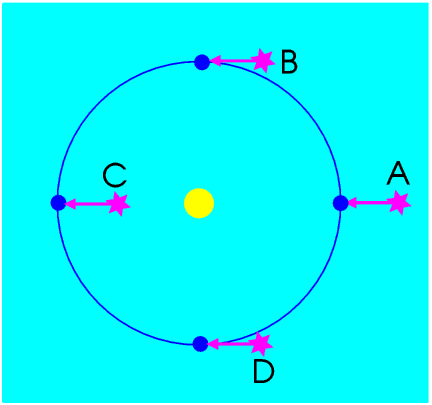
About three months later, in Position B, it will reach its highest point in the sky at about Sunset, so it will rise at about midday and set at about midnight, so it will be visible from just after Sunset until about midnight.
About three months later, in Position C, it will reach its highest point in the sky at about midday, so it will rise about Sunrise and set about Sunset, so it will not be visible at all.
Every star except a circumpolar star therefore has a period of invisibility, this was important to the ancient people, who thought it had gone into the Underworld.
About three months later, Position D, it will reach its highest point in the sky at about Sunrise so it will rise about midnight and set about midday so it will be visible from about midnight to just before Sunrise.
So it will reach its highest point in the sky a little earlier each day. After a whole year it will be a whole day earlier, so it works out at about four minutes earlier each day. Sam and his Granddad had actually measured this when Sam was staying with him.
The heliacal rising of a star, from the Greek for rising with the Sun, is the first time it becomes visible again after its period of invisibility. It is not very important to most young Star Watchers today, because they are naturally much more interested in what is happening in the sky after Sunset, before they go to bed, than what is happening in the sky before Sunrise, before they get up. So feel free to ignore this Paragraph. But the heliacal rising of a star bright enough and important enough to have been given its own name was very important indeed to the Ancient Astronomers, particularly the Ancient Egyptians.
Once a year the Earth the star and the Sun line up, with the Sun between the Earth and the star - this is Position C in the picture above.

But they are not at the same height in the sky (unless the star is on the ecliptic), we cannot see the star not because it is behind the Sun but because the sky is too bright.

When the Earth and star and Sun are lined up in this way the star will be at its highest point in the sky at midday and will be rising at about Sunrise and setting at about Sunset, so it will not be visible. The time the star sets gets earlier by about four minutes every day. Thirty days before the Earth Sun and star are in a straight line the star will be setting two hours after Sunset, so the sky will become dark enough for the star to become visible a long time before it sets. This time becomes less each day, and eventually there will come a night when the sky becomes dark enough for the star to be visible only just as it is setting. The following night it will not be visible at all: the Ancient People thought it had “died.”
On the days after this the process is reversed; one special morning the star will become visible again (only for a short time of course, until the sky is too bright), rising in the Eastern sky just as the Sun is beginning to light it up. This first reappearance of the star in the dawn sky, its Rebirth after its time in the Underworld, is called its heliacal rising.
Today the brightest star in the sky is called Sirius but the Ancient Greeks called it Sothis and the Ancient Egyptians called it Serpet. The time between two heliacal risings of a star is a sidereal year (from the Latin sidus for a star or constellation); because of precession a sidereal year is about 20 minutes longer than a solar year. Today at the latitude of Egypt the heliacal rising of Serpet, after seventy days of invisibility, occurs in August, but at the very dawn of the Ancient Egyptian civilisation, more than six thousand years ago, it occurred much earlier, immediately before the start of the annual inundation of the River Nile, and so was used to mark the start of the Egyptian New Year - this is described much more fully on the Page on The Egyptian Calendars.© Barry Gray October 2022